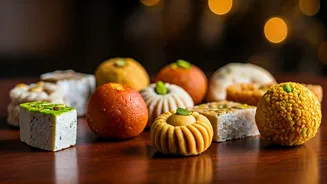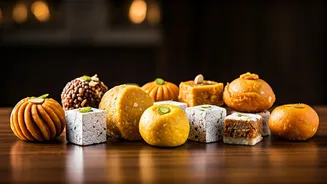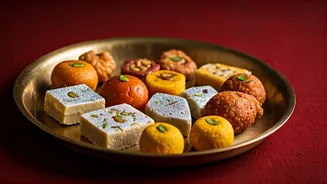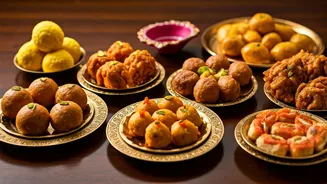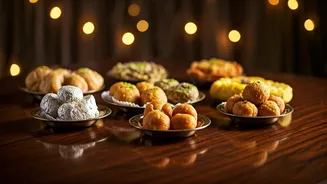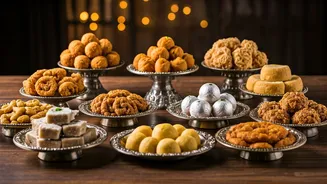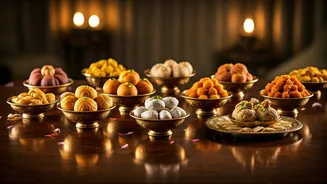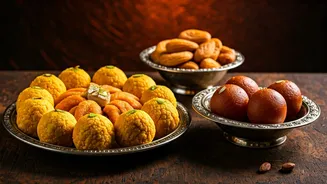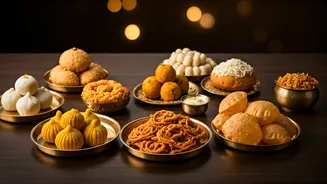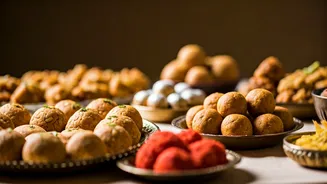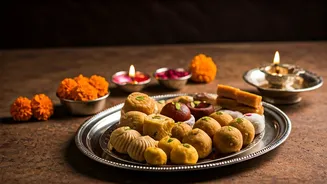Food for Gods
Diwali, the festival of lights, is marked by a deep reverence for deities, especially Goddess Lakshmi, the embodiment of wealth and prosperity, and Lord
Ganesha, the remover of obstacles. Preparing specific foods to offer to these deities is an integral part of the Diwali rituals. The offerings symbolize gratitude and invite blessings of prosperity and well-being into homes. These food items are not mere sustenance; they are expressions of devotion, meticulously prepared and presented, reflecting the essence of the festival. The selections are rooted in tradition, with each ingredient and preparation method carrying symbolic meaning, enhancing the spiritual atmosphere of Diwali celebrations.
Ladoo for Ganesha
Ladoo, particularly the Besan Ladoo and Motichoor Ladoo, is a staple sweet offered to Lord Ganesha, well-known as 'Modak-priya' (fond of modaks). These round, golden sweets symbolize sweetness, good fortune, and the joy associated with the festival. The preparation often involves gram flour (besan) or tiny droplets of fried batter (motichoor), combined with sugar and often spiced with cardamom and nuts. Offering ladoo is seen as a way to please Ganesha, ensuring the removal of obstacles and the beginning of new endeavors with positivity. The sweetness of ladoo represents the desired sweetness in life, making it a fitting offering for a prosperous festival like Diwali.
Kheer for Lakshmi
Kheer, a creamy rice pudding, is a favored offering for Goddess Lakshmi. Its preparation varies across regions, using ingredients like rice, milk, sugar, and often flavored with cardamom, saffron, and nuts. The smooth, rich texture and sweet taste of kheer represent abundance and the nurturing qualities of Lakshmi. Offering kheer signifies the desire for prosperity and the sustenance of good fortune. Serving kheer during Diwali invokes blessings for a bountiful year and the establishment of lasting prosperity for all the celebrants. The creamy, comforting nature of kheer adds to the festive ambiance, making it a delicious and spiritually significant treat.
Poha for Festivities
Poha, a flattened rice dish, is a common offering during Diwali, especially in various Indian households. It is a light, easy-to-prepare dish, often seasoned with spices, onions, and peanuts. Poha represents simplicity and the ease with which prosperity can be welcomed into one's life. Offering poha acknowledges the importance of starting the day with something nourishing and auspicious. Preparing and eating poha during Diwali signifies the desire to begin the festival with a clean slate and a positive attitude, ensuring a year filled with good health, and success, while welcoming positivity.
Halwa for Blessings
Halwa, a sweet pudding made from semolina (sooji), wheat flour, or carrots, is a central part of Diwali's culinary offerings. Each type has its unique significance. Halwa’s preparation symbolizes the effort taken in achieving success. Offering halwa, especially Sooji Halwa, to the deities acknowledges the blessings received, seeking continued prosperity and well-being for the family. The richness and sweetness of halwa represent a wish for a life abundant with joy and success. Its presence at the Diwali pooja adds a touch of festivity and a reminder of the sweeter aspects of life.
Mithai's Sweetness
A collection of various sweets, or 'mithai,' is a customary offering. These can range from barfis and pedas to gulab jamuns and rasgullas. The diversity of sweets represents the variety of blessings and the richness of life that is wished for during Diwali. Offering a selection of sweets symbolizes the sharing of joy and prosperity among family, friends, and the community. Mithai's rich textures and diverse flavors add to the celebratory feel of Diwali, emphasizing the festival's sweet and auspicious nature. The tradition of gifting sweets during Diwali signifies the intention to spread happiness and foster togetherness.
Puri-Bhaji Combo
Puri-bhaji, a combination of deep-fried bread (puri) and a vegetable curry (bhaji), is often presented as a festive meal during Diwali. This combination represents a balanced offering, signifying both material prosperity and the spiritual nourishment of the soul. The deep-fried puris symbolize the indulgence in celebrations, while the bhaji, often made with vegetables, represents the health and sustenance needed to enjoy these festivities. The completeness of the meal mirrors the wholeness and completeness wished for in life, making it a meaningful offering.
Malpua Tradition
Malpua, a pancake-like sweet, fried and soaked in sugar syrup, holds significance as an offering. This sweet is offered to Goddess Lakshmi. Its preparation and consumption symbolize the welcoming of prosperity and the wish for a life filled with sweetness and abundance. Offering Malpua signifies a wish for a year as sweet and delightful as the dessert itself. The use of traditional ingredients and methods adds to the cultural richness of the Diwali celebrations, making it a time-honored offering to Goddess Lakshmi.
Sabudana Khichdi
Sabudana khichdi, a dish made from sago pearls, is a light, easily digestible offering often included in the Diwali offerings. It is believed that Sabudana Khichdi symbolizes purity and simplicity, reflecting the values of gratitude and devotion. Offering Sabudana Khichdi during the festival symbolizes a desire for a peaceful and pure mind, which is conducive to spiritual growth and well-being. This light offering complements the richer foods of the festival, ensuring a balance in the diet, and maintaining health during the Diwali festivities. The dish's simplicity reflects the essence of the festival, which is celebrating with a clean heart.
